Too much yelling while anchoring? Try this tried and true method for ghosting in silently, and getting underway without waking your neighbors.
Search for anchoring information and you’ll likely find article after article discussing the virtues of an anchor, windlass, or other gadget. Get a few sailors together and inevitably someone asks, “What anchor do you have,” launching a long debate. But if you don’t have a good system of communication for deploying, setting and raising your anchor, it can turn into a yelling match or worse, lead to an urgent dragging situation.
Practicing strong communication skills often gets overlooked in favor of learning the technical skills, such as reefing or navigating. And because it doesn’t seem hardcore or rugged, it is neglected at many sailing conferences, or if offered, it is skipped over by participants. But practicing effective communication techniques will take your sailing experience, safety, and enjoyment to the next level.
It is nearly impossible to yell over engine and wind noise, so many people opt for expensive headsets. But we’ve been using good-old hand signals for years, a process that is more than a few gestures. It’s an entire system.
The guiding principle
This system has one critical guiding principle — the person at the helm (helmsman) is in control, making and executing all decisions regarding vessel maneuvers, based on all available information. The bow person’s (bowman) role is to relay information to the helm, effectively becoming an extra set of eyes and ears.
I’ve seen it and I’ve heard it — people trying to drive the boat from the bow. It usually goes like this… “ok, come ahead, keep coming ahead, good… Ok, STOP. STOP! Reverse! Reverse!” This technique is doomed to fail. The bowman should be focused on the anchor and the chain, not boat traffic, wind, current, VHF chatter, and the myriad of other things the helmsman must focus on. Additionally, the helmsman will have a delayed response to verbal commands.
The two step system
Being able to hear someone more than 25 feet away isn’t reliable. So our anchoring communication system is nearly silent. Always. We come in calm and quiet. It’s beautiful. It’s poetic. And our neighbors never stir when we slip away at 0430.
There are two steps:
- Give clear and succinct information. Continue giving the signal until you have confirmation that the other person sees it.
- Acknowledge you’ve received and understand the information by repeating the signal.
For example, when the bowman tells the helmsman (using hand signals that I will tell you about next) that the “anchor is off the bottom,” the helmsman always repeats the expression. This signals they saw and understood the information being relayed to them. If the helmsman doesn’t repeat the signal because they are busy or didn’t see it clearly, then the bowman continues to repeat it until they do.
The hand signals – Raising the anchor
Haul Away
The bowman positions him/herself at the bow, watching the helmsman waiting for the signal to haul away. This is simply a thumbs up. When the bowman sees a thumbs up, they repeat the signal and then begin to haul away the anchor.
Chain Direction & Angle
Knowing the direction and angle of the chain is critical information that must be relayed during the entire anchoring process. To relay that info to the helmsman, we mirror the chain with our arm. Rather than pointing to the anchor, we point our arm in the same direction and angle as the chain, but in the air. This is more visible to the helmsman than a lowered arm which often obscured by a mast, cabinhouse, or dodger.
The direction the chain leads indicates the direction to the anchor. The angle of the chain indicates how much strain is on the chain. With these two—direction and angle, the helmsman can make decisions about how much rudder angle and throttle is required to steer towards the anchor and simultaneously relieve strain on the windlass.
The arm is continuously raised. It’s angle and direction must be changed to match the chain as the boat motors ahead and the chain is brought aboard. If the boat begins to overrun the chain, it is the job of the bowman to indicate that by angling the arm aft, towards the mast.
This arm signal is equally useful while deploying the anchor. By using it, you are telling them that you are letting chain out and what angle it is – therefore indicating if it has hit the bottom yet.
To give a little more info, we add a pointed finger to indicate the windlass is hauling, and a closed fist to indicate the windlass is stopped. We prefer to run our Maxwell 3500 electric windlass when there is light-medium strain on the chain. So the pointed finger also indicates a light strain, while the closed fist indicates either a heavy strain, we have overrun the chain, or some other fouling. It does not mean “stop.” Remember, the bowman is not telling the helmsman what to do.
Up and Down
The final stage of “hauling back” the chain is traditionally known as “short stay” or “straight up and down.” This occurs when the chain left out is nearly equal to the water depth. We give the signal for “anchor up and down” by raising one arm vertically up and down right next to our head, almost scraping along our ear. The helmsman responds by repeating the signal to indicate he/she has seen it.
Anchor Off the Bottom aka Anchors Aweigh
When the anchor is breaking out of the seafloor, your windlass might bog down a little. In sticky mud the bow of the boat may even dip. The break-out can be subtle. Getting to know when your anchor has broken out is an acquired skill. Once the anchor is free, the boat is adrift and the bowman must let the helmsman know. An alert helmsman will be aware of the boats movement and the hand signal will serve to confirm that you are both aware of the drift, and on the same page. The hand signal we like to use is a downward pointing fist rocking back and forth. We think this looks like a swinging anchor. The fist represents the anchor that is free from the bottom to swing on it’s chain. This is known as “anchors aweigh” Many people confuse this term and often misspell it as “anchor’s away,” They think it it means “to drop anchor.” To avoid confusion, we call this “anchor off the bottom.”
Eyes on The Anchor, or Anchor Sighted
When the anchor becomes visible just below the surface we indicate that by pointing to our eyes with our pointer and middle finger of the same hand. Sometimes, we’ve done this so quickly it looks like we are flashing the peace sign. In the clear waters of the Tropics you may see the anchor during the entire evolution, but what’s important to convey to your helmsman at this time is that the anchor is at or just beneath the surface.
The boat is now able to motor ahead at slow speeds if needed, as there won’t be dangling chain banging the hull. Sometimes, in a tight anchorage, or place with swift current, this maneuvering-ability can’t come soon enough. Here are two of our Morse Alpha students having fun doing their Robert DeNiro, “I’m Watching You” impressions, which means they see the anchor.
Anchor Aboard
The final signal lets the helmsman know that the anchor is aboard and he/she can proceed at normal speed. For this signal we touch fingertips to shoulder. We hold this position – like all other hand signals – until the helmsman sees it and repeats the signal. This, like all our other signals, only requires one arm leaving the other arm free to hold onto the boat and/or the wash-down hose. After the anchor is aboard, and the helmsman repeated the signal indicating they saw it, we lock the windlass and secure the anchor with a safety line. We finishing the entire evolution with a two-arm wave that mimics a first base umpire calling a “safe”.
The hand signals – Dropping the anchor
Drop the Anchor
This is the opposite of ‘haul away.’ It’s simply a thumbs down. Easy.
Anchor is set
Both the bowman and the helmsman are watching for the moment when you know the anchor is set. We gently motor in reverse (with a modified snubber on to relieve the stress on the windlass) until we notice the boat stop and sometimes surge forward a little. The signal for this is the same as the ‘safe’ signal in a baseball game.
Snub it up
When deploying the anchor, once the helmsman determines that it is set and they don’t want to move, they give the signal for ‘snub it up’ – a single finger circling in the air. The bowman puts the snubber on and we are officially anchored. We keep a regular eye on our position to ensure we are not dragging or swinging into danger.
Complete List Of Signals:
Haul away your anchor
Hauling
Not hauling
Chain up and down
Anchor off the bottom
Anchor sighted
Anchor aboard
All secure
Drop the anchor
Anchor is set
Snub it up
We have used this method for hundreds of silent anchorings. Try and debate its merits – and, well, you’ll just have to see us in action. Teresa says it is like executing a triple pirouette, finishing in a passe and not ever being off balance.


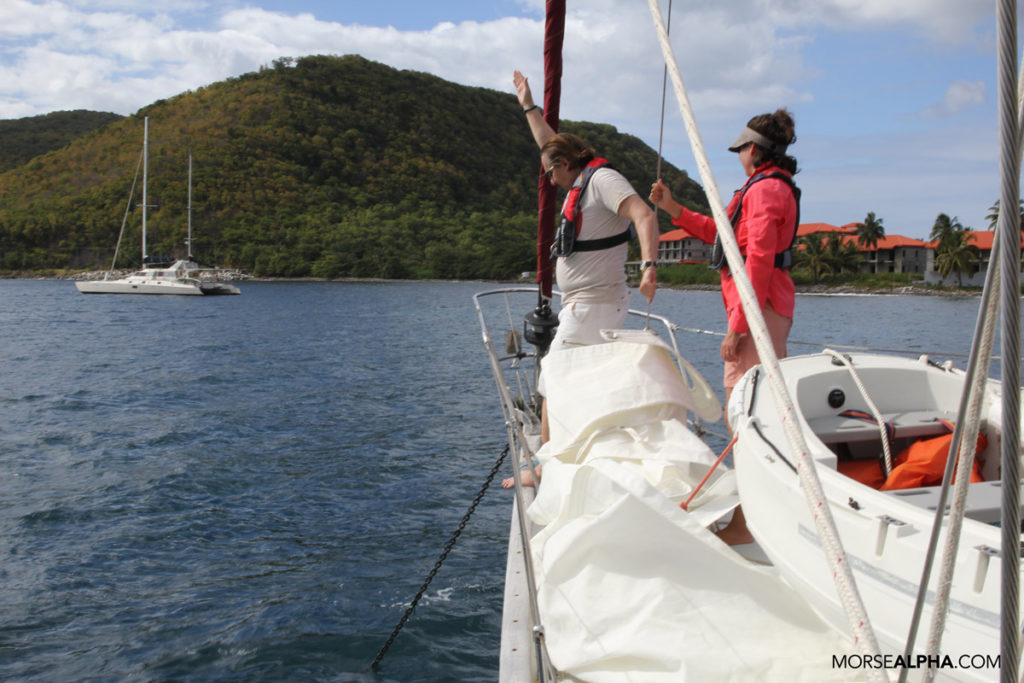
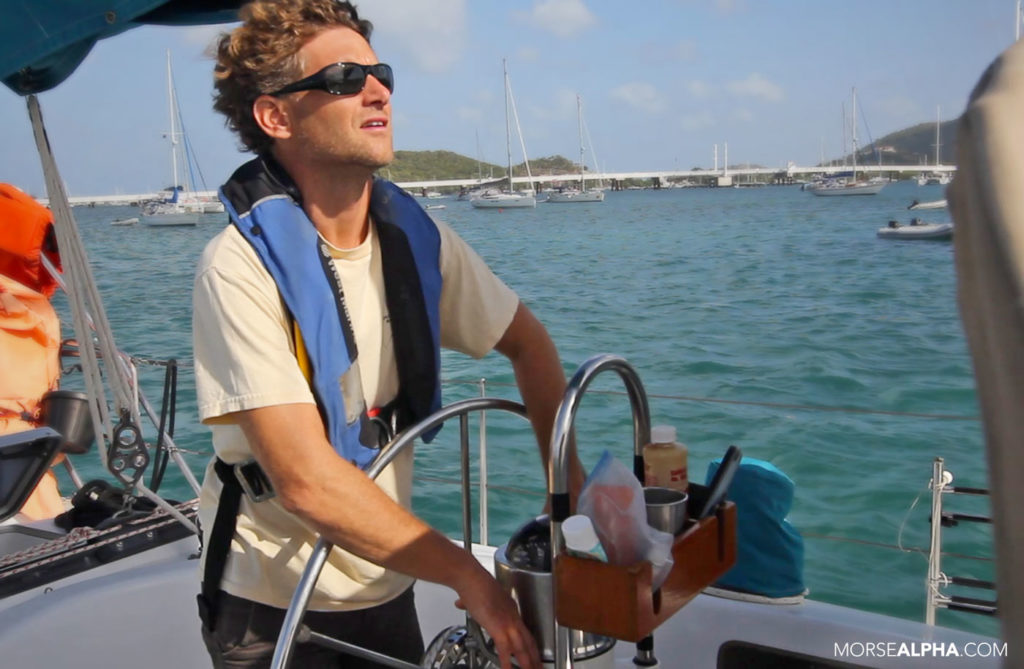
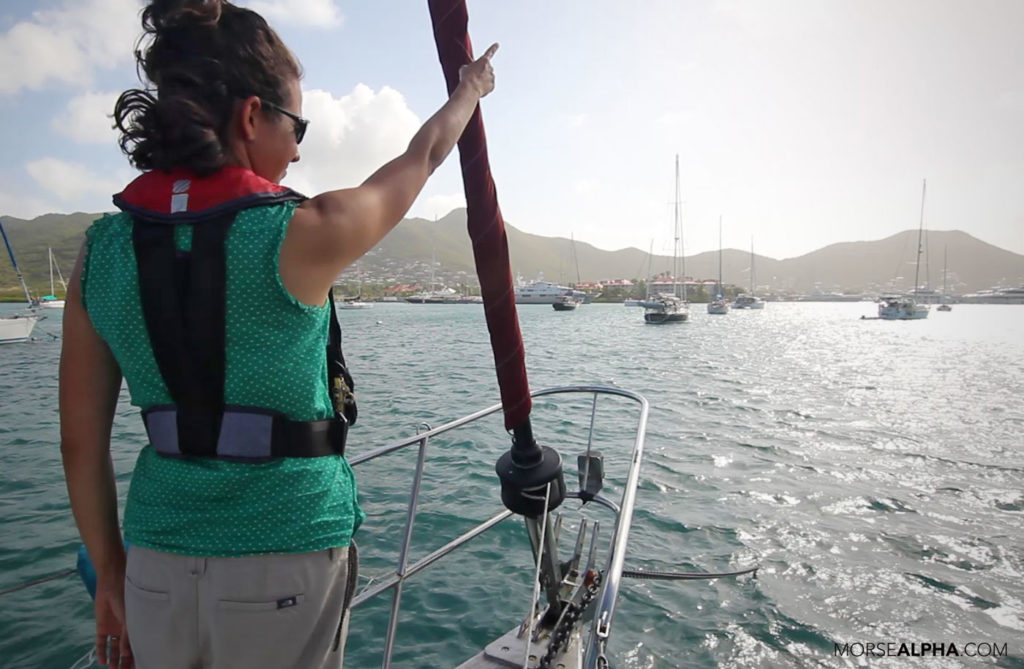
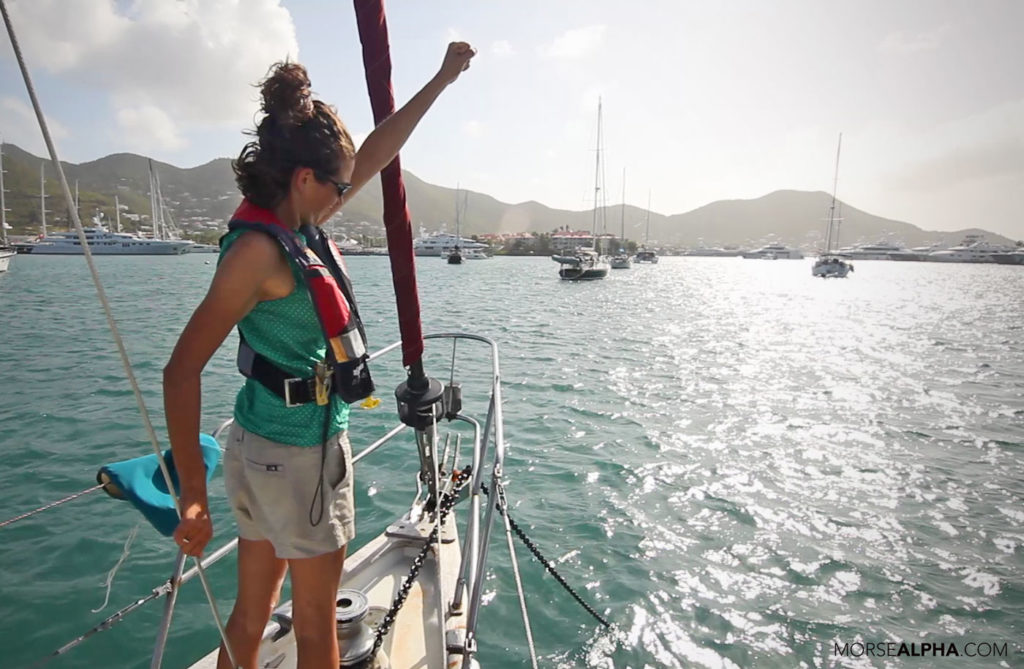
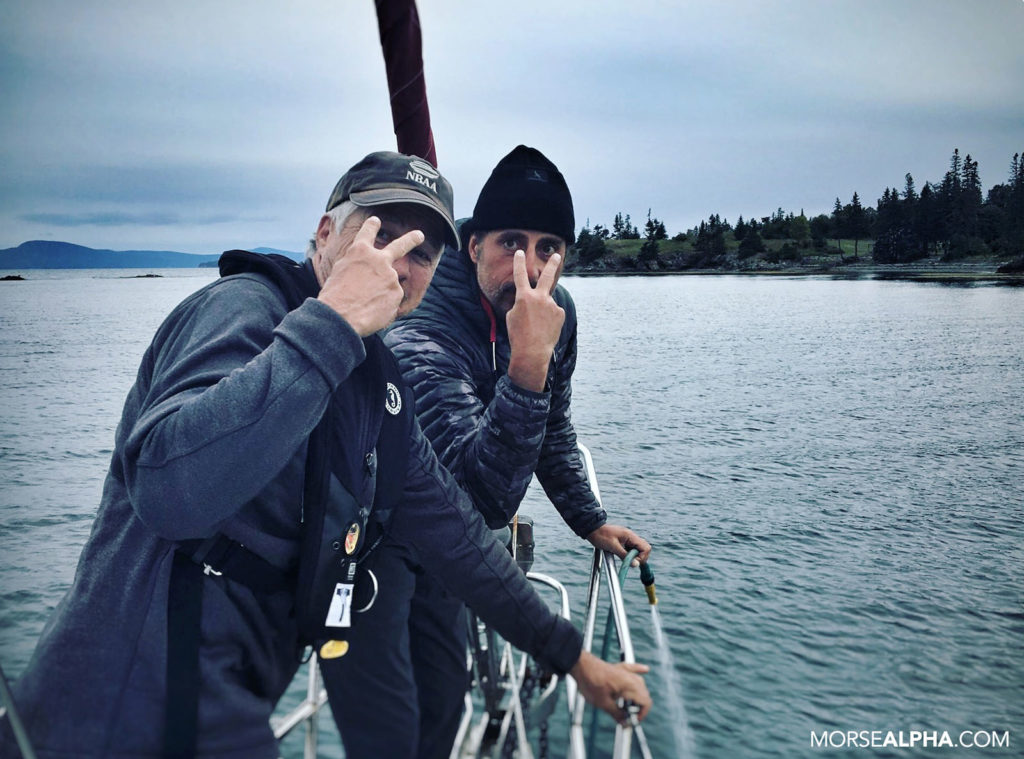
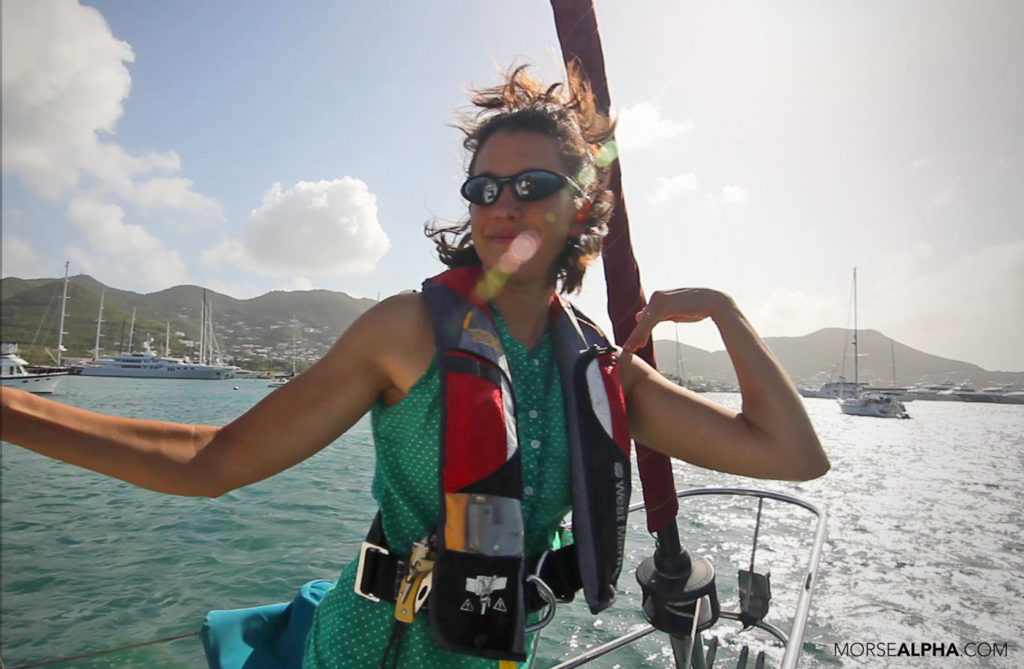

Comments 4
Thank you providing wonderful guidance for all of us.
I love that you mentioned the importance of the confirmation signal (step #2) before anything else. Hand signals truly do enable communication between bowman and helmsman (or woman), and I’d say have improved our marriage (less yelling/miscommunication on board) when we are on the water, for sure! Thankyou for sharing these specific hand signals–we’ll be adding a few more to our list!
Sailing instructors please note! Hands signals are so much better than shouting. Thanks for sharing.
Great Article , The hand signals are the key. We always use them so we were gratified to read your endorsement.
Here is how we differ slightly from your approach:
Setting the Anchor:
The helms man is in charge until the anchor is lowered. The helmsman makes the decision on where to set the anchor, and informs the bow person of the depth and preferred scope. This is verbal, such as, “125ft”. The signal to drop is also verbal: ” OK, drop!” Or if it is a noisy location, a emphatic downward pointing action.
Now the bow person takes control. As the anchor runs out and the boat drifts or is gently powered backward, no signals are given. When the proper scope is out and the boat fetches up on the anchor the bow person signals to back down. This signal is a hand pointed upward and twirled in a circular motion: “Rev it up”. The bow person is testing the holding with (listen to this!) their toe on the chain. They can feel exactly how the anchor is setting or if any motion is occurring. When the bow person deems the anchor to be holding, they give a “Cut” signal, which is like a flat hand, palm down, waved horizontally. The helm person can then secure the engine. If the anchor is dragging and does not hold, there is a negative head shaking followed by a cut and they then come back to consult, Usually this is followed by a shift of location and another attempt.
Raising the Anchor:
We do not power up to the anchor. We let the windlass pull the boat up to the anchor and if the strain is enough to slow the windlass we stop hoisting for a moment and let the weight of the chain move the boat up to the anchor. What we do is hoisting and washing the chain. One person operates the windlass and the other is on the bow with a saltwater wash-down hose and nozzle. The person washing is in a good position to stop the hoist just before the anchor comes to the roller. Then that person goes aft to take the engine controls and the helm while the other person finishes getting the anchor aboard and the deck washed off.
This technique has woke for us for 38 years.